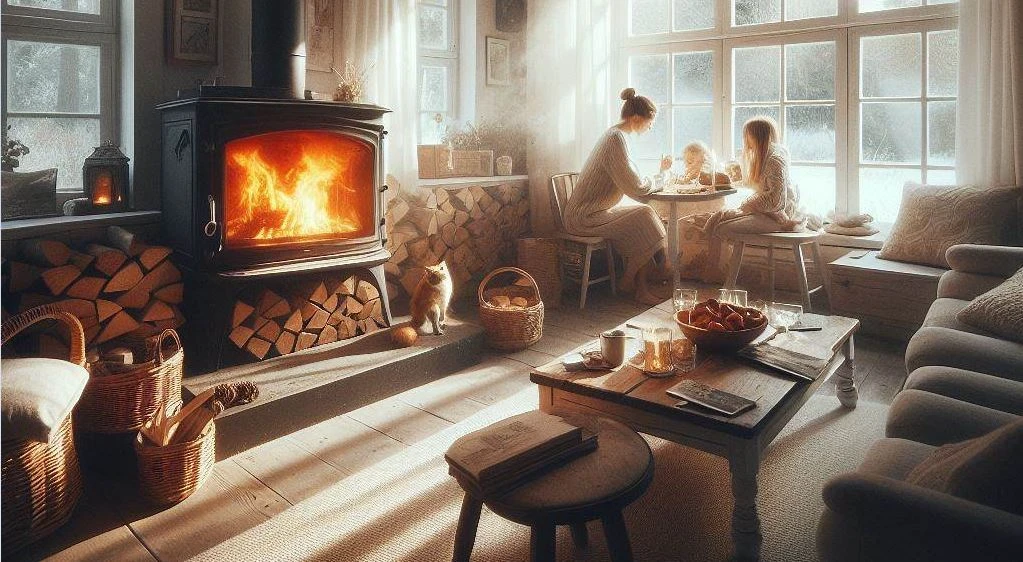Over Firing Wood Stove! Is it Dangerous?
Over firing a wood stove refers to a situation where the stove operates at temperatures higher than its design limits. This usually happens due to excessive fuel or oxygen supply. Over firing can cause significant damage to the stove and its surroundings.
Yes, over firing a wood stove is dangerous. It can cause the stove and its components to overheat, leading to warping, cracking, and even potential fire hazards in your home.
Fire on a wood burner should be controlled to prevent over firing. Recognizing the signs of over firing is essential for safe stove operation. These signs include red-hot stove panels and an unusual increase in drafting noise, indicating a high oxygen demand. Another warning sign is a phenomenon called whuffing, where the stove vibrates noticeably.
The internal temperature of a wood-burning stove typically ranges between 400 and 600 degrees Fahrenheit. Exceeding these temperatures can lead to over-firing, posing risks such as warping, weakening, or cracking of metal components. Over firing not only damages the stove but also leads to unnecessary fuel expenditure.
To avoid over firing, it’s advised to control the amount of fuel added to the stove and manage the airflow. Strategies include spreading out the coals, adjusting the air intake, and using a stove fan to distribute heat more evenly. In some cases, opening windows or doors can help moderate the stove’s temperature.
Heat-resistant ceramic tiles can also be used to protect surrounding areas. Water spritzing is a method to dampen the fire, though it must be done cautiously to avoid steam injuries or damage to the stove.
Opening the stove’s dampers can allow more air to flow, helping to cool the stove. Other methods like turning down the airflow, opening the stove’s door, dampening logs or embers, and using baking soda can also be effective in managing the fire’s intensity.
Overfiring can lead to overheating, potentially damaging the stove, stovepipe, and adjacent structures, posing a risk of house fires.
Over Firing in Wood Stoves
Over firing a wood stove occurs when the fire inside the stove burns hotter than the stove’s intended operating temperatures. This usually results from excessive fuel or excessive air supply, which leads to a fire that is too large or too hot for the stove to handle safely.
Typically, over firing is a result of user error, such as adding too much wood or leaving the air intake open too long. It can also happen when there’s a desire for more heat output than the stove can safely provide.
Knowing the balance between adequate heating and safe operation is key to preventing over firing.
Learn More: 5 Common Quadra-Fire Wood Stove Problems, and Their Fixes
The Risks of Over Firing a Wood Stove
Operating a wood stove beyond its intended capacity can pose serious dangers. Over firing generates extreme heat, which can lead to structural damage to the stove itself, such as warping or cracking. This damage can compromise the stove’s safety features and efficiency.
Over firing increases the risk of fire hazards in the surrounding area, including the potential for igniting nearby combustible materials.
Prolonged over firing can also damage the flue system, leading to unsafe operating conditions and increased risk of carbon monoxide poisoning.
Signs of Over Firing Wood Stove
1. Red-Hot Stove Panels: If the stove’s body becomes visibly red-hot, it’s a clear sign that the stove is operating at dangerously high temperatures.
2. Increased Drafting Noise: A loud drafting sound indicates that the fire is demanding more oxygen than usual, a symptom of over firing.
3. Whuffing Sounds: Unusual noises like whuffing, where the stove vibrates or makes popping sounds, are warning signs.

How to Cool Down a Wood Stove Quickly?
1. Reduce Airflow: Closing the air intake valves helps to reduce the fire’s oxygen supply, gradually lowering the temperature.
2. Spread the Coals: Evenly distributing the coals can help to dissipate the heat more effectively.
3. Use a Stove Fan: A stove fan can help to circulate the hot air away from the stove, aiding in cooling.
4. Open Windows or Doors: This can help to reduce the room temperature and indirectly cool the stove.
5. Water Spritzing: Lightly spritzing water onto the coals can help cool them down, but this should be done cautiously to prevent steam burns or damage to the stove.
What Temperature Is Too Hot for a Wood Stove?
Wood stoves are designed to operate efficiently within a specific temperature range, usually between 400 to 600 degrees Fahrenheit. Temperatures exceeding this range can lead to over firing.
Stove thermometers are essential tools for monitoring and maintaining safe operation temperatures. Operating the stove consistently within the recommended temperature range ensures both safety and efficiency, reducing the risks associated with over firing.
Being aware of the maximum safe temperature for your specific stove model is crucial for preventing damage and maintaining a safe heating environment.
